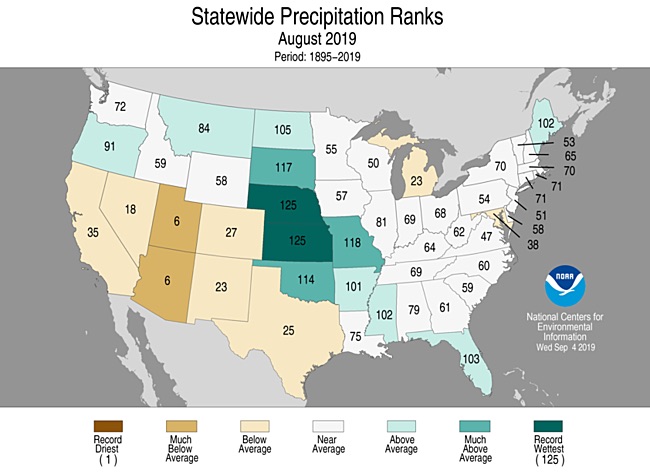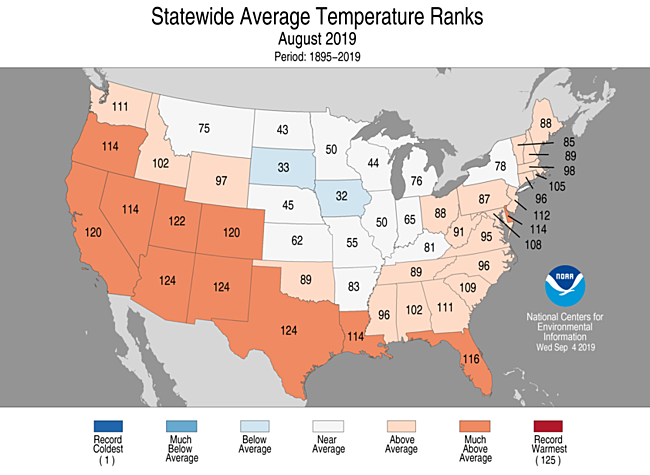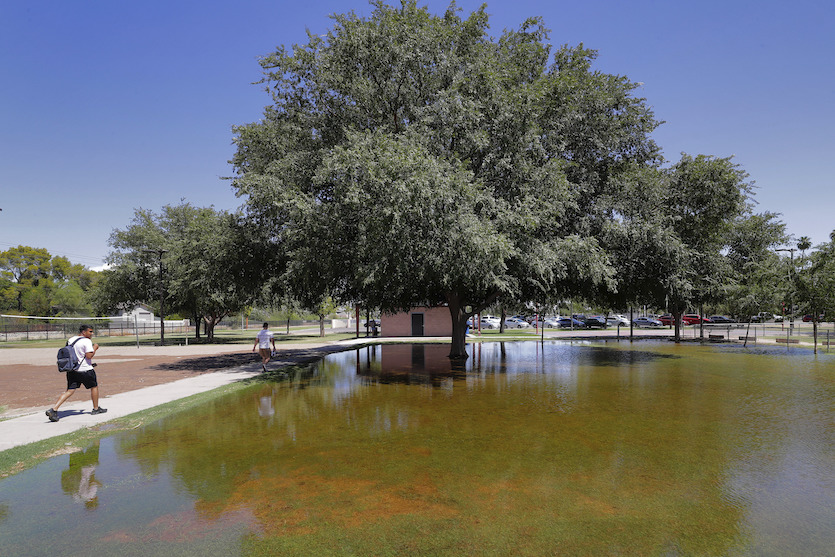| Above: Corn grows in a saturated farm field on May 29, 2019 near Emden, Illinois, the nation’s second largest corn-producing state. Near-record rainfall in parts of the Corn Belt led to unprecedented planting delays, according to the U.S. Department of Agriculture. More favorable growing conditions in August and early September boosted the prospects for the 2019 corn harvest somewhat. Image credit: Scott Olson/Getty Images. |
A slightly wetter-than-average August helped keep the contiguous U.S. on track for its wettest calendar year on record, according to NOAA’s monthly climate statistics released Friday. The nation saw its 45th-wettest August out of 125 years of recordkeeping. March and July are the only two months in 2019 that have been drier than average for the 48 contiguous states.
For the year to date (January-August), the precipitation total of 24.59” handily tops the previous record of 24.23” set just two years ago, in 2017. The top five wettest Jan-Aug periods have all occurred since 1979.
 |
| Figure 1. Precipitation totals for 12-month spans from September to the following August, going back to 1895. The span from September 2018 to August 2019 trounced the previous record for all Sept.-Aug. periods. Image credit: NOAA/NCEI. |
The last 12 months (September 2018 – August 2019) are the wettest Sept.-to-Aug. span by far, with the 37.55” total smashing the previous record of 34.43” (Sept. 1972–Aug. 1973). This period also landed in fourth place among all of the 1496 overlapping 12-month spans going back to January 1895. Amazingly, the eight wettest of these 12-month spans—and nine of the ten wettest—have occurred in the last five years. Even given the fact that a very wet span of a few months will be factored into such listings more than once, this is still remarkable testimony to the power of our warming climate to make extreme rain events even more extreme.
Here is the top-ten list:
37.86" July 2018–June 2019
37.73” August 2018–July 2019
37.68” June 2018–May 2019
37.55” September 2018–August 2019
36.20” May 2018–Apr. 2019
35.95” May 2015–Apr. 2016
35.78” Apr. 2015–Mar. 2016
35.73” Mar. 2018–Feb. 2019
35.63” Feb. 1973–Jan. 1974
35.49” Apr. 2018–Mar. 2019
 |
| Figure 2. Statewide rankings for average precipitation for August 2019, as compared to each August since records began in 1895. Darker shades of green indicate higher rankings for moisture, with 1 denoting the driest month on record and 125 the wettest. Image credit: NOAA/NCEI. |
The most noteworthy rainfall event in August was the series of intense thunderstorm complexes—resembling late spring more than late summer—that developed over the central High Plains and bulldozed their way into the Southern Plains. One of those storms gave Colorado a preliminary record for its largest hailstone ever observed (4.83”, beating 4.5”).
Meet the family who collected Colorado's record-setting hailstone. And @russ_schumacher takes an official measurement! Many thanks again to @BrianBledsoe, and to the family who graciously opened their home to a bunch of ecstatic scientists. https://t.co/nv1Lv48I51
— ColoClimateCenter (@ColoradoClimate) August 15, 2019
Power flickering on and off here in NW OKC. The most lightning I’ve seen in a long while. #okwx pic.twitter.com/EBsuntj5xg
— Justin Hughes (@jhughes722) August 27, 2019
Both Nebraska and Kansas had their wettest August on record, and South Dakota and Missouri placed in the top ten. Arizona and Utah had top-ten-driest summers.
Parched conditions helped give Arizona, New Mexico, and Texas their second hottest August on record. California, Utah, and Colorado had top-ten-hottest Augusts. Only South Dakota and Iowa were significantly cooler than average.
 |
| Figure 3. Statewide rankings for average temperature for August 2019, as compared to each August since records began in 1895. Darker shades of red indicate higher rankings for heat, with 1 denoting the coldest month on record and 125 the warmest. Image credit: NOAA/NCEI. |
Highlights of summer 2019
Summer 2019, including August, was not phenomenally wet for the contiguous U.S., coming in as the 32nd wettest summer on record. This confirms that the tremendous precipitation amounts in late 2018 and early 2019 are still making their presence felt in the year-to-date and 12-month averages.
Arizona had its driest summer on record—a clear sign of the weakness of this year’s tepid North American Monsoon, the seasonal pattern that drives moisture from the tropics into the Southwest each summer. In Phoenix, the total precipitation for monsoon season thus far (June 15 through September 8) was just 0.41”, the fourth lowest for that period in data going back to 1895. Flagstaff received a mere 1.22” for that period, its least for any monsoon season to date in records back to 1899 (beating out 2.03” from 1978).
 |
| Figure 4. An irrigation-flooded park keeps a grassy area alive on August 27, 2019, in Tempe, Arizona, during one of the city’s driest summers on record. Image credit: AP Photo/Matt York. |
California, Utah, and New Mexico each had top-ten-driest summers, while Kentucky, Nebraska, South Dakota, and Tennessee had top-ten-wettest summers.
While the midsection of the contiguous U.S. had near-average temperatures for summer as a whole, most of the nation was warmer than average. Eight states had a top-ten-hottest summer: Connecticut, Delaware, Florida, Maryland, Massachusetts, New Jersey, New Mexico, and Rhode Island. No states were significantly cooler than average.
In Alaska, cooler- and wetter-than-average conditions prevailed in the northeast, while southern and western Alaska continued to rack up remarkable warmth. As of Monday, September 9, Anchorage has gone more than 100 days without a single cooler-than-average day. See Chris Burt’s writeup on Alaska’s amazing warmth in June and July. Chris will also have a post shortly on summer 2019 in both Alaska and Hawaii.
This was the 2nd warmest summer past 95 years in Alaska. Since 1997 there have now been seven summers warmer than ANY summer was between 1925 & 1996. This is a clear example of systematic environmental change: what was unheard of is now routine. #akwx #Arctic @Climatologist49 pic.twitter.com/1j33bkyL2K
— Rick Thoman (@AlaskaWx) September 7, 2019



